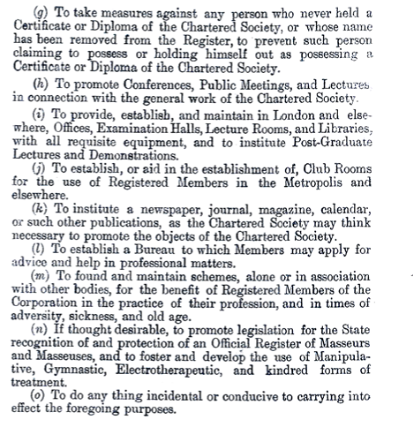As the Canadian Physiotherapy Association celebrates its centenary year, 2020 also marks an important historical milestone for the Charted Society of Physiotherapy in the UK – 100 years since it received a Royal Charter.
On June 11th19201, his Majesty, King George V, granted the Incorporated Society of Trained Masseuses and the Institute of Massage and Remedial Gymnastics (two massage organisations in the UK) a Charter of Incorporation to amalgamate and become the Chartered Society of Massage and Medical Gymnastics (now known as the Chartered Society of Physiotherapy).
The Charter which set out the constitution, powers and objectives (pasted below) of the new organisation, aimed to improve the status and public usefulness of the profession.

 The grant of a Royal Charter was a mark of distinction for the Society, as only one organisation in any given profession can hold one. As a significant symbol of status, attained through state recognition of a body pre-eminent in its field, the Charter provided a tangible measure of reassurance to the public. Its award was cause for great celebration among members of the newly formed Society which included an event with tea, fruit salad and ices at the Langham Hotel in London to greet the Charter.
The grant of a Royal Charter was a mark of distinction for the Society, as only one organisation in any given profession can hold one. As a significant symbol of status, attained through state recognition of a body pre-eminent in its field, the Charter provided a tangible measure of reassurance to the public. Its award was cause for great celebration among members of the newly formed Society which included an event with tea, fruit salad and ices at the Langham Hotel in London to greet the Charter.
Wicksteed2, in her history of the Chartered Society of Physiotherapy 1894-1945, notes that the idea to seek a Royal Charter came originally from the solicitor of the Incorporated Society of Trained Masseuses, in part to protect the society from rival massage organisations and factions. The Society of Trained Masseuses, which became Incorporated in 1900 had, since its inception in 1894, sought to fend off rival massage organisations, such as the British Massage Association founded by Thomas Maltby (a masseur and hypnotist from London)3, the National Association of Trained Masseuses and Masseurs Ltd., and the Harley Institute of Massage. In relation to the Institute of Massage and Remedial Gymnastics, a ‘flourishing’ but rival organisation based in Manchester1, the Incorporated Society of Trained Masseuses considered a merger the optimal course of action.
The petition for a charter, put forward by the chairs of both organisations (Evelyn Bliss and William Milligan) along with Lucy Robinson (a founder member of the Incorporated Society of Trained Masseuses), was the culmination of work by a subcommittee of the Council of the Incorporated Society of Trained Masseuses. The progress of the ‘Charter Committee’ can be followed in the meeting minute books of the Council (accessed in the archives of the Chartered Society of Physiotherapy at the Wellcome Library Wellcome library in London, and makes for interesting reading, with plenty of evidence of professional and political manoeuvring.
Although the Charter was issued 100 years ago, it nevertheless played a pivotal role recently, in 2008, when the Charted Society of Physiotherapy published a new scope of professional practice. The objects of the Charter which helpfully included kindred methods of treatment(alongside Massage, Medical Gymnastics and Electrotherapeutics) provided the Society with a fourth pillar of physiotherapy practice, thereby enabling advanced practice activities undertaken by some physiotherapists (for example, injection therapy), to be neatly situated within its existing professional boundary.
Sources:
- Barclay J (1994) In Good Hands: The history of the Chartered Society of Physiotherapy 1894-1994.Oxford: Butterworth-Heinemann
- Wicksteed JH (1948) The growth of a profession: Being the history of the Chartered Society of Physiotherapy 1894-1945. London: Edward Arnold & Co
- Maltby T (1885) The massage question. The Nursing Record9thJanuary:47

